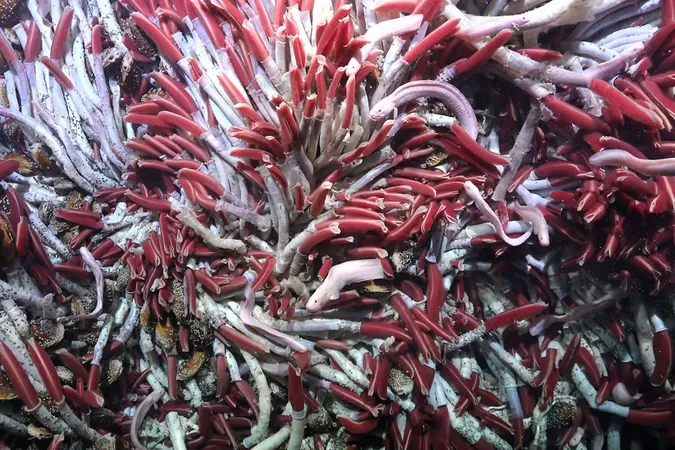
Shocking Discovery! Giant Worms Unearthed in Oceanic Depths Raise New Questions About Life’s Limits!
2024-11-26
Author: William
Groundbreaking Expedition
In a groundbreaking expedition, researchers aboard the Schmidt Ocean Institute's research vessel, Falkor, made an astonishing discovery at the East Pacific Rise, a notorious active volcanic ridge over 2,500 meters beneath the ocean surface. Initially, the team aimed to collect rock samples from hydrothermal vents in order to study how tubeworm larvae settle. However, they stumbled upon something much more extraordinary.
A Hidden Ecosystem
As the team's remotely operated vehicle, SuBastian, began to lift plates of oceanic crust, it unearthed cavities filled with hydrothermal fluid at a depth of about 10 centimeters. These chambers, although previously recognized by geologists, revealed a consistent, warm temperature of 25°C. But what appeared on the screens next stunned the scientific community: a hidden ecosystem teeming with life!
Among the remarkable findings were:
- Snails
- Mussels
- Giant tubeworms (scientific name: Riftia pachyptila)
This complex community of life existing in such unanticipated depths challenges our previous understanding of life’s resilience in extreme conditions. It opens new avenues of inquiry into where life can exist, including the possibility of similar ecosystems beyond Earth—perhaps even on moons like Europa.
Meet the Giants of the Deep: The Riftia pachyptila
Among these discoveries, the giant tubeworms stand out as true leviathans of the ocean floor, capable of growing up to three meters long! Known colloquially as giant beard worms, these remarkable organisms have adapted to thrive in environments that are entirely devoid of sunlight, subject to extreme pressure, and rich in toxic chemicals.
The finding of Riftia pachyptila in subterranean cavities raises important questions about how they survive and reproduce. Researchers speculate that larvae from the ocean floor might travel into subsurface areas through hydrothermal fluids, hinting at a dynamic interplay between the diverse ecosystems found on the ocean floor and below it.
Environmental and Astrobiological Implications
This astonishing discovery holds significant implications, not just for our understanding of marine life but for astrobiology as well. The intricate relationships within these ecosystems underscore the importance of environmental protection. As scientists become increasingly aware of the interconnectedness of marine habitats, the urgency for safeguarding these delicate environments intensifies.
Moreover, this newfound "biomass layer" is already facing threats from burgeoning deep-sea mining projects. Experts are urging immediate protective measures to prevent irreversible damage to these unique ecosystems.
The revelation of giant worms residing in deep-sea cavities serves as a reminder of how much we have yet to uncover about our planet’s oceans. As we deepen our exploration of these extreme environments, we stand to gain invaluable insights that may shape our understanding of not only marine biology but also the potential for life in other parts of the solar system.
With ongoing missions such as NASA’s Europa Clipper, designed to examine Jupiter’s icy moon Europa—which is believed to harbor volcanic activity and a subsurface ocean—astronomers and biologists alike are eager to answer the question: Could life thrive in environments resembling those found around Earth’s hydrothermal vents?
As we venture further into the ocean's depths, it becomes thrillingly clear that our planet’s oceans still hold countless mysteries waiting to be unveiled. The discovery of giant worms is likely only the dawn of a fascinating new chapter in marine biology and the quest for extraterrestrial life!









 Brasil (PT)
Brasil (PT)
 Canada (EN)
Canada (EN)
 Chile (ES)
Chile (ES)
 España (ES)
España (ES)
 France (FR)
France (FR)
 Hong Kong (EN)
Hong Kong (EN)
 Italia (IT)
Italia (IT)
 日本 (JA)
日本 (JA)
 Magyarország (HU)
Magyarország (HU)
 Norge (NO)
Norge (NO)
 Polska (PL)
Polska (PL)
 Schweiz (DE)
Schweiz (DE)
 Singapore (EN)
Singapore (EN)
 Sverige (SV)
Sverige (SV)
 Suomi (FI)
Suomi (FI)
 Türkiye (TR)
Türkiye (TR)